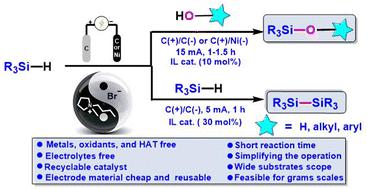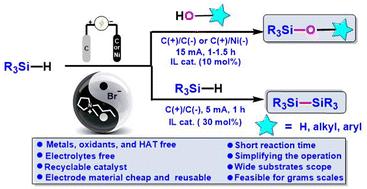Electrochemical oxidative dehydrogenation of hydrosilanes to generate silyl radicals: an efficient method for the construction of Si–O/Si–Si bonds utilizing a recyclable ionic liquid catalyst†
IF 11.3
1区 化学
Q1 CHEMISTRY, PHYSICAL
引用次数: 0
Abstract
A highly efficient and sustainable approach was developed for the construction of Si–O/Si–Si bonds, through the electrochemical oxidative dehydrogenation of hydrosilanes with O-nucleophiles (e.g. phenols, naphthols, alcohols, and H2O) or hydrosilane self-condensation. The protocol employs a highly electrically conductive and recyclable ionic liquid as a catalyst, thus eliminating the need for external electrolytes and hydrogen atom transfer (HAT) agents. The ionic liquid could be easily recovered and reused for at least eight cycles with consistent performance. Notably, this electrochemical method exhibits a broad substrate scope and high functional-group compatibility (66 examples, up to 96% yield). Initial mechanistic studies show that silicon radicals are generated via the process of hydrogen atom transfer between bromine radicals and silanes, and KIE experiments demonstrate that Si–H bond cleavage is the rate-determining step of the reaction.


利用可回收离子液体催化剂对氢硅烷进行电化学氧化脱氢以生成硅基:一种构建 Si-O/Si-Si 键的高效方法
通过氢硅烷与 O 型亲核物(如酚、萘酚、醇和 H2O)的电化学氧化脱氢反应或氢硅烷自缩合反应,开发出了一种构建 Si-O/Si-Si 键的高效、可持续方法。该方案采用高导电性和可回收的离子液体作为催化剂,因此无需外加电解质和氢原子转移(HAT)剂。离子液体可轻松回收并重复使用至少八个周期,且性能始终如一。值得注意的是,这种电化学方法具有广泛的底物范围和较高的官能团兼容性(66 个实例,收率高达 96%)。初步的机理研究表明,硅自由基是通过溴自由基和硅烷之间的氢原子转移过程产生的,KIE 实验证明,Si-H 键裂解是该反应的决定性步骤。
本文章由计算机程序翻译,如有差异,请以英文原文为准。
求助全文
约1分钟内获得全文
求助全文
来源期刊

ACS Catalysis
CHEMISTRY, PHYSICAL-
CiteScore
20.80
自引率
6.20%
发文量
1253
审稿时长
1.5 months
期刊介绍:
ACS Catalysis is an esteemed journal that publishes original research in the fields of heterogeneous catalysis, molecular catalysis, and biocatalysis. It offers broad coverage across diverse areas such as life sciences, organometallics and synthesis, photochemistry and electrochemistry, drug discovery and synthesis, materials science, environmental protection, polymer discovery and synthesis, and energy and fuels.
The scope of the journal is to showcase innovative work in various aspects of catalysis. This includes new reactions and novel synthetic approaches utilizing known catalysts, the discovery or modification of new catalysts, elucidation of catalytic mechanisms through cutting-edge investigations, practical enhancements of existing processes, as well as conceptual advances in the field. Contributions to ACS Catalysis can encompass both experimental and theoretical research focused on catalytic molecules, macromolecules, and materials that exhibit catalytic turnover.
 求助内容:
求助内容: 应助结果提醒方式:
应助结果提醒方式:


